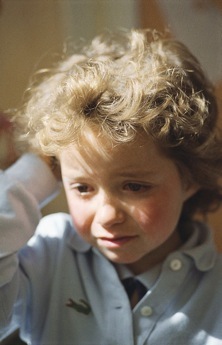-
Children’s Health Problems






Croup
Croup causes swelling around vocal cords and airways. Children usually get croup between 3 months and 5 years of age. It is a scary, but not usually dangerous condition. Croup often occurs several days after a child has mild symptoms of a cold.
Signs & Symptoms
-
•A cough that sounds like a seal’s bark.
-
•Hoarseness.
-
•A harsh, crowing noise with breathing in.
Symptoms of croup can also be like symptoms of more serious problems. These include:
-
•Epiglottitis. This is a bacterial infection that can cause the back of the throat to swell up. If the throat is blocked, breathing in is very difficult. Severe respiratory distress can result. Signs of epiglottitis are:
-
-Drooling.
-
-Hanging the head down.
-
-Sticking out the jaw to breathe.
-
-Fever.
-
•Something can be stuck in your child’s windpipe.

Causes
Croup is usually caused by a certain virus. Other viruses, allergies, bacteria, and inhaled foreign objects can mimic croup.
Treatment
Self-care measures can treat symptoms. Croup usually goes away in 3 to 7 days. It is usually worse at night. Emergency care is needed for severe problems breathing.
With croup, the child has a hard time breathing in.








Self-Care / Prevention
-
•Don’t panic. You can help your child stay calm if you stay calm. Hold your child to comfort him or her. The windpipe may open up a little if your child relaxes. Call your child’s doctor or get immediate care if you are not sure what to do.
-
•Go into the bathroom with your child and close the door.
-
1.Turn on the hot water in the sink and shower. Let the steam fill the room.
-
2.Don’t put your child in the shower. Sit with your child. (Don’t sit on the floor.) Read a book or play a game with your child. This will help pass the time.
-
3.Open the window to let cool air in. This helps make more steam.
-
4.Stay in the bathroom about 10 to 15 minutes.
-
•If it is cold outside, instead of using the bathroom to make steam, put a coat, etc. on your child and take him or her outside to breathe the cold night air.
-
•Use a humidifier in your child’s room. Use warm, distilled water, not tap water. Clean the humidifier every day.
-
•Put a humidifier on your furnace. Change the filter often.
-
•Give your child a clear liquid. Warm it first. Warm liquids may help loosen the mucus. Give babies under 6 months old water orelectrolyte water, such as Pedialyte, if okay with your child’s doctor. Give water, apple juice, etc. to a child who is 6 months old or older.
-
•Crying is a good sign. It means your child is getting better.
To Help Prevent Croup and Other Infections
To Help Prevent Croup and Other Infections
-
•See that your child’s immunizations for diphtheria (DTaP), measles (MMR), and H. influenzae type b (Hib) are up-to-date. (See Immunization Schedule.)
-
•Follow prevention measures in Colds & Flu.
Does the child make a high, whistling sound like a barking seal?
Without having trouble breathing, is the child doing all of the following?
-
•Drooling.
-
•Breathing through the mouth.
-
•Sticking the chin out.
Does the child have a hard time breathing and is he or she doing these things?
-
•Drooling.
-
•Breathing through the mouth and gasping for air.
-
•Sticking the chin out.
Does the child have any of these problems?
-
•Blue color around the lips or fingernails.
-
•Extreme shortness of breath.
-
•Listlessness or severe weakness.
-
•Coughing so much that your child can’t take a breath.
-
•Inability to swallow or make sounds normally.
Questions to Ask



Get more information from:
HealthyLearn® | www.HealthyLearn.com. Click on MedlinePlus®.
The American Academy of Pediatrics | www.aap.org




Copyright © 2009, American Institute for Preventive Medicine. All rights reserved.